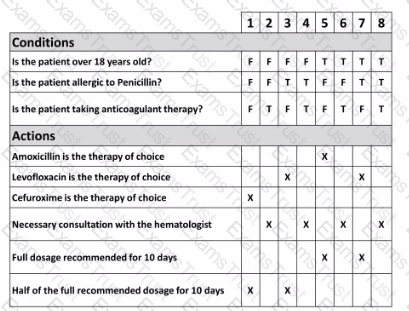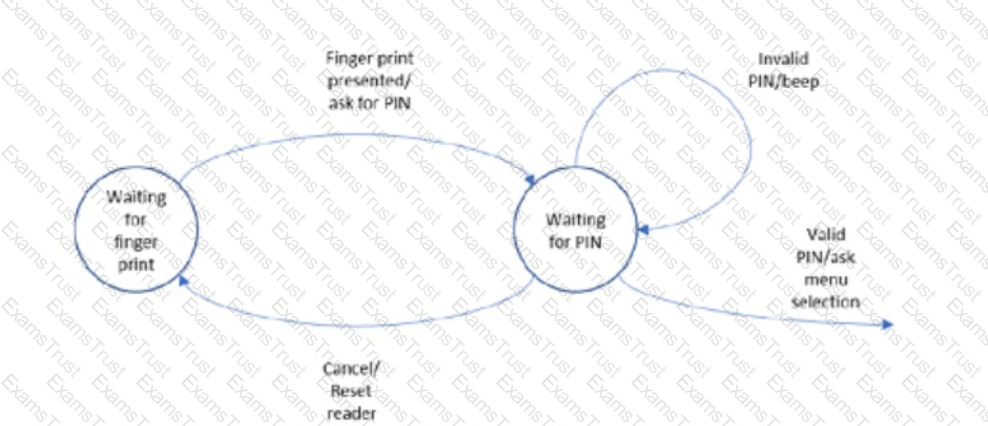Which of the following is a test-first approach, where tests that express a shared understanding from stakeholders of how the application is expected to work, are first written in business-readable language (following the Given/When/Then format), and then made executable to drive development?
Consider the following simplified version of a state transition diagram that specifies the behavior of a video poker game:

What Is the minimum number of test cases needed to cover every unique sequence of up to 3 states/2 transitions starting In the "Start" state and ending In the "End" state?
Which of the following coverage criteria results in the highest coverage for state transition based test cases?
Which of the following statements about the testing quadrants is TRUE?
Which of the following statements about the value of maintaining traceability between the test basis and test work products is not true?
A document descnbes the test procedures that have been derived for the identified test sets Among other things, the order in which the test cases in the corresponding test set are to be executed according to the dependencies described by preconditions and postconditions is specified This document is a typical work product produced as part of:
To be able to define testable acceptance criteria, specific topics need to be addressed. In the table below are the topics matched to an incorrect description. Match the topics (the left column) with the correct description (the right column)
TopicDescription
Which of the following work products cannot be examined by static analysis?
Which of the following statements refers to a good testing practice that applies to all software development lifecycles?
Scenario 1 “Happy Tomatoes” (used for questions 20-22):
An intelligent application for agricultural use incorporates temperature sensors located at different points of an enclosure. The sensors measure and record the temperature at regular intervals and extract the statistical values for these measurements. These values include the average daily temperature.
A new variety of tomatoes is currently being grown and the“World Organization for Happy Tomatoes”has established temperature ranges related to vegetative development.
When the system establishes that the average temperature is within a specific range, it emits a value that will be used to monitor and control the crop.

Using theequivalence partitioningtechnique, identify the set of input values that provides the HIGHEST coverage.
Which of the following is a task the Author is responsible for, as part of a typical formal review?
Which of the following statements is TRUE?
Which of the following is a factor that contributes to a successful review?
Exploratory testing is an experience-based test technique
Consider the following list of activities (I to V):
I. Test design
II. Test planning
III. Review test basis
IV. Be a facilitator of a peer review
V. Test monitoring and control
Which ONE of the following options identifies the activities that the test management role is MAINLY focused on?
Atypical generic skill required for the role of tester is the ability to
The following decision table is used to assist a doctor in determining the drug therapy to prescribe for a patient (aged 6 to 65 years) diagnosed with acute sinusitis. The table consists of three Boolean conditions and six actions

Based only on the given information, which of the following statements is TRUE?
Which of the following statements best describes the difference between product risk and project risk in software testing?
The following 4 equivalence classes are given:

Which of the following alternatives includes correct test values for x. based on equivalence partitioning?
Which ONE of the following options BEST describes Behavior-Driven Development (BDD)?
Which of the following statements is true?
Which of the following statements about TDD, BDD and ATDD is TRUE?
Which of the following best describes the relationship between a test progress report and a test summary report?
Which ONE of the following options isNOTa benefit oftest automation?
Which of the following is not an example of a typical generic skill required for testing?
Select which of the following statements describe the key principles of software testing?
i. Testing shows the presence of defects, not their absence.
ii. Testing everything Is possible.
iii. Early testing Is more expensive and is a waste of time.
iv. Defects cluster together.
v. Testing is context dependent.
vi. Beware of the pesticide paradox.
vii. Absence of errors is a fallacy.
Select the correct answer:
Which of the following statements about the shift-left approach is true?
In which of the following test documents would you expect to find test exit criteria described9
Which of the following statements about static testing and dynamic testing is true?
A system has a self-diagnostics module that starts executing after the system is reset. The diagnostics are running 12 different tests on the systems memory hardware. The following is one of the requirements set for the diagnostics module:
'The time taking the diagnostics tests to execute shall be less than 2 seconds' Which of the following is a failure related to the specified requirement?
Which of the following statements about the typical activities of a formal review process is TRUE?
Match each objective to the correct test level
Objective:
A)Verifying whetherthe functionalandnon-functlonalbehaviorsof the system are as designed andspecified.
B)Verifying whetherthe functionalandnon-functlonalbehaviorsof the interfaces are as designed.
C)Verifying whetherthe functionalandnon-functionalbehaviorsof the components are as designedand specified.
D)Establishing confidence in the quality of the systemas a whole.
Test Level:
1.Component testing.
2.Integration testing.
3.System testing.
4.Acceptance testing.
In Agile teams, testers closely collaborate with all other team members. This close collaboration could be problematic and result in testing-related organizational risks.
Which TWO of the following organization risks could be encountered?
I.Testers lose motivation and fail at their core tasks.
ii.Close interaction with developers causes a loss of the appropriate tester mindset.
iii.Testers are not able to keep pace with incoming changes in time-constrained iterations.
iv.Testers, once they have acquired technical development or business skills, leave the testing team.
Which of the following characterizations applies to a test tool used for the analysis of a developer's code prior to its execution?
Who of the following has the best knowledge to decide what tests in a test project should be automated?
Which of the following is not an example of a typical content of a test completion report for a test project?
Which of the following statements is an example of testing contributing to higher quality?
The whole-team approach:
Which two of the following statements describe the advantages provided by good traceability between the test basis and test work products?
I. Analyzing the impact of changes.
ii. A measure of code quality.
iii. Accurate test estimation.
iv. Making testing auditable.
Select the correct answer:
The following state transition diagram describes the functionality involved in a system using fingerprint and password authentication to log onto a system.

How many distinct states of the system are visible in the above diagram?
You are performing the role of tester on an Agile project. Which of the following tasks would be your responsibility?
i. Understanding, implementing, and updating the test strategy.
II. Ensuring the proper use of testing tools.
Hi. Coaching other team members in the relevant aspects of testing.
iv. Actively collaborating with developers and business stakeholders to clarify requirements, especially in terms of testability, consistency, and completeness.
v. Participating proactively in team retrospective meeting, suggesting and implementing improvements.
Select the correct answer:
Which of the following is a role that is usually responsible for documenting the findings (e.g., action items, decisions, recommendations) made by the review team as part of a typical formal review?
Which sequence of stated in the answer choices is correct in accordance with the following figure depicting the life-cycle of a defect?

Which ONE of the following options identifies the perspectives through which acollective authorship processgenerates a shared vision of user stories?
Which ONE of the following is a GOOD testing practice that is INDEPENDENT of the chosen SDLC (Software Development Life Cycle) model?
Which of the following lists factors That contribute to PROJECT risks?
A possible risk of introducing test automation is:
Which of the following statements about the shift-left approach is FALSE?
A state transition diagram describes a control system’s behavior in different operational modes. The initial state is“NORMAL MODE”.
Which ONE of the following test cases covers anINVALID sequence?
Which ONE of the following activities TYPICALLY belongs to the planning phase of the review process?
Which ONE of the following statements would you expect to be the MOST DIRECT advantage of the whole-team approach?
Which of the following statements best describe Behavior-Driven Development (BDD)?
Which of the following statements about checklist-based testing is TRUE?
Determining the schedule for each testing activity and test milestones for a test project, using activity estimates, available resources, and other constraints is a typical task performed during
Which of the statements correctly describes when a whole team approach may NOT be suitable?
Which one of the following is a typical entry criteria for testing?